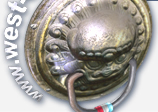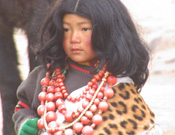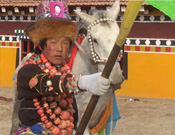| 10 Days Losar Tour In Amdo
Day 1. Arrive at Chengdu / Gurgo
Upon arrival, drive 240km along the Zumg-chu (Minjiang), one of
the main tributaries of the Yangtze River to Gurgo Valley. Overnight
Hot Spring Hotel or other similar hotels **
Day 2.
Drive 240km to Ngawa (Chi: Aba Alt: 3200m), we will cross two passes,
the first with an elevation of 4000m and second 3700m where you
will have great views to look far into the distance. In Tibetan
Ngawa means: Men who beat drums. The old people explain Ngawa is
the first place where the King Songtsen Gampo conferred and awarded
the title to warriors during the 7th century. For centuries, Ngawa
is one of the largest nomadic areas in Eastern Tibet. As one of
the important Tibetan cities in Amdo and the central of Tibetan
culture, religion, trade and communication, you will have a strong
feeling of atmosphere of real Tibetan culture and life here. Especially
during the festival time, as this area has not yet formally opened
to foreigners for a long time, the strong local culture has less
influenced from other nations till these days. The way of their
celebrating the festivals is still keeping strong old traditional
way during the New Year (Losar) time in different sects monasteries.
Highlights to see are Jonangpa and Benpo monasteries’ activities
including dresses of monks, masks dances and the way of pray as
they all are rear to see in whole Tibet nowadays. Overnight Jingu
Hotel. ** Good rooms with facilities and heating, but I will inform
you a new better and warmer hotel when I will be confirmed.
Day 3.
We drive 2km to Kirti Gonpa, the largest Gelukpa monastery in Ngawa,
built in 1472 by one of disciples of Tsongkhapa and it has about
more than 1000 monks now. At 9:00am, about 3000 monks pray together
in Assembly Hall, some monks come from other monasteries nearby.
The very low and high tones from their chanting fill the air and
seams to purify everything. Can easily make your brain empty and
make your body blood circulation smoothly. At about 9:40pm, a ceremony
for Sunning the Buddha begins and a big Tangkha of Tsongkhapa displays
in front of Assembly Hall in a quite different way from other Gelukpa
monasteries in Amdo area. The Sunning the Buddha (Tib: Khakhl) first
held in 1468 by the first Dalai Lama, Gendun Drub (1391—1474).
At beginning the size of the Tangkha was smaller and after 4th Panchen
Lama, Lobzang Chokyi Gyeltsen (1567—1662), the size changed
to bigger and bigger till present size. In Ngawa many ceremonies
during the New Year Festivals (Tib: Losar) are still held in old
traditional ways. After lunch we drive 3km to one of the oldest
and few sect Jonangpa Setenling Gonpa to see a very different ceremonies
of Sunning the Buddha and Turning the Buddha. Jonangpa or Jonang
Sect was first founded in the middle of 13th century, till 14th
century, this sect became one of the strangest religion in Tibet
and spread to Amdo at that time. During 17th century, the fifth
Dalai Lama changed most Jonangpa monasteries to Gelukpa, and only
few were left in remote area, such as in Zamtang, Pema and Ngawa.
After Jonangpa monastery festival, we drive back to Kirti Gonpa
to see a heated Knowledgeable Debating by monks in front of thousands
of nomadic people. Then to see a competition of feats of strength
by the fighting monks (Dobdo). Usually this activity is held by
the monks, but at this monastery it has been held by the local people
for the last couple years.
Day 4.
At 9:30 am, first we see a guard of honor of 70 nomadic men with
their own decorated horses who were selected from a tribe, which
gives majority donation to the monastery this year. All men are
strong and well dressed with countless and colorful jewelries decorated.
After one hour, Masks Dance by monks starts accompanying strong
monastic music. The dance is quite different from other monasteries
we see in Repkong. The mask dance starts at 10:30 am and runs till
6 pm. The fire prayer (Trogyak) starts at 4 pm. If you like you
also can go to see the mask dance in Gomar Monastery which is located
20 km north of Ngawa (town) and is also a very important branch
of Kerti Monastery. Stay in same hotel.
Day 5.
Drive to Nangshuk (Narshi) Monastery, the largest Bon monastery
in Tibet. It is a branch monastery of Mingling in Western Tibet.
There are 800 monks living there. They practice both Bon Tantra
and Sutra. You can also visit the Bon College and Hospital in the
monastery. In the morning, you can see the circling dance, which
is an unusual festival in Tibet. All the monks walk around the temple
playing religious musical instruments. After the festival you will
have time to visit Tokden Monastery (Bon) which is located east
of Nangshuk Monastery. The whole monastery has been rebuilt recently.
The monastery also has a mask dance ten days before the Nangshuk
Festival. On the way to the hotel you can visit some of the local
Tibetan families and wonderful wooden houses. Stay in the same hotel.
Day 6.
Drive to Nangshuk Monastery at 8am. The local people burn incense
offering in front of the protector temple. This is one of the most
important and highlights parts of the festival to see in Nangshuk.
After the incense offering, all the local people walk to the monastery
with horses and very fancy dresses. More than tree hundred herdsmen
walk slowly to the crows, they hold different color flags and decorated
horses. Wearing traditional typical nomadic chubas and hats, piling
with jewelers on each one’s body. They symbolize the treasures
and backbones of Tibetan people in Amdo. In old days, they were
selected from sharpshooters. They all appear bold and powerful manner
with inflexible will. Usually the mask dance starts around 10 am
till 4 pm. normally there some differences between the Buddhist
masks and the Bon masks as far as visual appearance, but the meaning
behind Bon & Buddhist mask dances can be very different. About
4 pm after the last ceremony, we drive 75km to Jiuzhi. Overnight
Juizhi Nianbo Hotel.
Day 7.
We drive for 385km via Dalag to Machen (Alt:3800m) in Tibetan means:
The highest mountain of the Yellow River. The county is the homeland
of the Tibetan Golok people, another strong tribe of Tibetan. The
Golok means: Marching strait ahead and never turn back your head.
If you want to have an experience of a real wild area, today’s
driving will make you satisfactory, we will pass over at least three
big mountain passes with altitude over 4200 meters, decorated with
different colored pray flags. You will meet many typical Golok nomadic
people on the way, they are strong and nice, and every aged people’s
charming face just like world classics and it is who, the nomadic
people live nearest to the nature for thousands of years and accumulated
rich knowledge about life which also full of various romantic stories.
We believe that because of their clean minds with kind hearts, most
of their bodies remain much more instinct feelings to receive the
positive energy from the nature and helpful waves from the monasteries.
We will also visit one or two old monasteries on the way. Overnight
Snow Mountain Hotel or other better Hotel, sometime no hot water
for shower. **
Day 8.
Drive 412km to Xining. Another wonderful day for picturesque landscape
while we drive: grassland with yaks and sheep and Snow Mountains,
maybe we could see few nomadic black and white tents at this season,
but more and more of them live in houses in Winter time now. Along
the Yellow River valley we will experience the red and Blue Mountains
and forestry. This part of driving concentrates many futures of
Amdo, the scenery is fantastic changeable geographically at every
short distance. Overnight 4 star Qinghai Hotel or other similar
hotels.
Day 9.
Fly to Guangzhou or other cities. But the flights to Guangzhou only
on (Mon.Wen.Fri.Sun.) in a week, please let me know your idea.
Please note: Maybe I suggest
to stay one night in Guide on March 7th from Machen as that day
is too long driving and less time for photos on the way. On 8th
March we drive 170 km to Xining, after lunch we drive for 30km to
visit Kumbum monastery (I think you never been there), overnight
Xining and next day Friday, March 9, you fly from Xining to Guangzhou.
Or if you have time you can take train to Lhasa.
|





